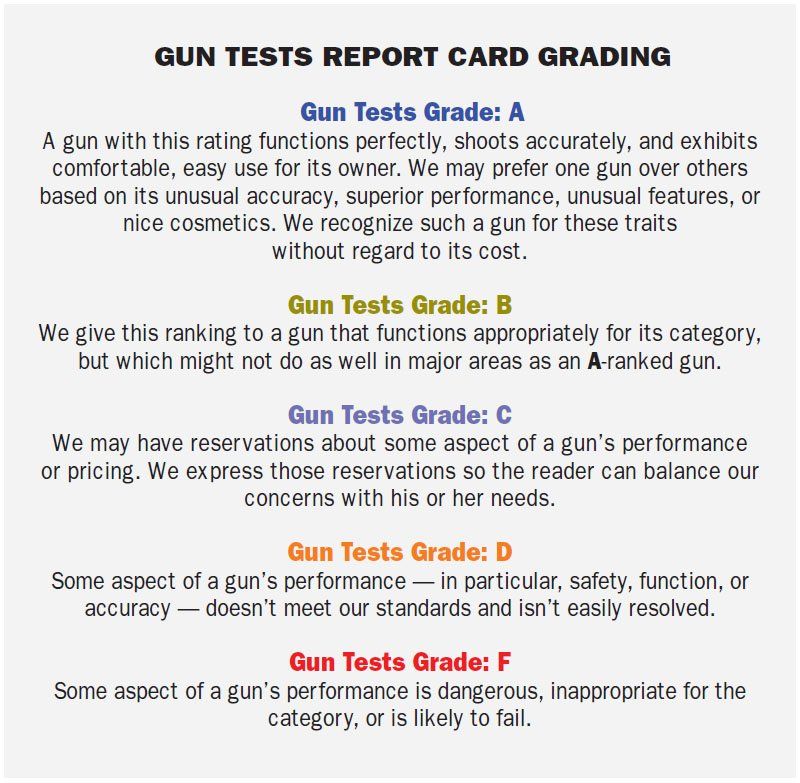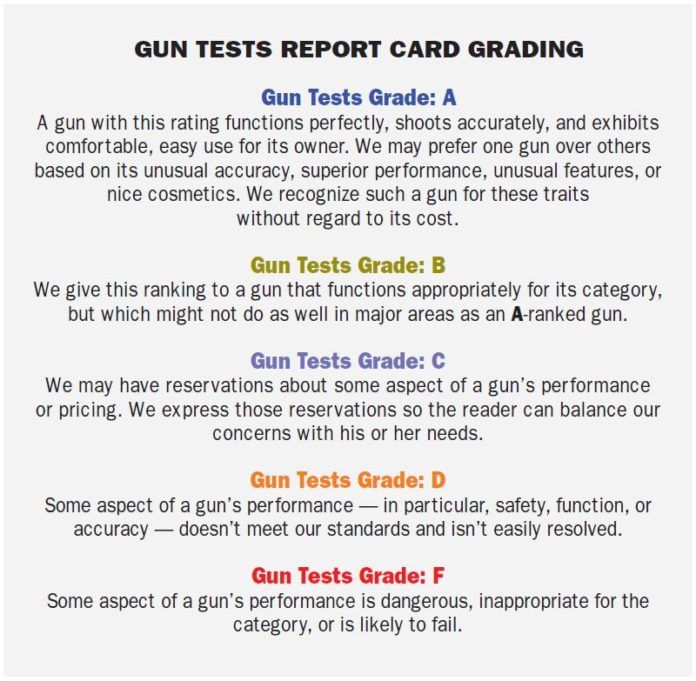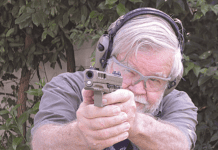Re “Firing Line,” August 2017
A couple of comments regarding your reader’s proposed revised rating method in the August issue. I agree that many gun manufacturers should have higher quality standards, but the market offers us a variety of quality and prices. With GT’s help, enthusiasts soon learn which manufacturers offer premium quality as opposed to bargain guns.
I like your present rating methods, as you thoroughly explain the reasons for your downgrades—and I can accept or disregard your reasons as they apply to my individual needs.

I’ve bought three new guns requiring factory repairs because of obvious faults, but in the first case, the honorable dealer sent it back at his expense, and twice the manufacturers issued UPS pick-up paperwork, so there was initial disappointment, but all cases were resolved without any cost to me.
Your reader asks who would want to buy a gun rated at C? About 12 years ago, I bought a new CZ 83 pistol. You would have rated this particular pistol an F because of constant Failure to Fire and Failure to Eject problems. But after CZ sent it back, the gun has been 100% reliable and has become a favorite because it perfectly fits my old, extra-large, and arthritic hands, and provides excellent accuracy with modest recoil. I was pleased to see your A rating on this gun years later. I’ve found giving each gun a second chance to be a worthwhile practice.
— Wil
I just received my August 2017 copy of Gun Tests and read the letter from Larry, the quality engineer. I agree with him regarding A and F grades, particularly with respect to giving an F to any new gun that is not fit for purpose right out of the box. I had an experience recently with a brand-new Smith & Wesson M&P 9mm, from their Performance Center no less. In theory, this should have been a cut above the “standard factory” product, but, much to my dismay, it completely failed to fire, right out of the box. Inserted loaded magazine, released slide to chamber round, put sights on target, pulled trigger, and NOTHING! Just a very frustrating “click.” There was apparently a problem with the firing-pin channel that was stopping the pin from contacting the primer when released by the trigger pull. Smith & Wesson, as you might expect, repaired the gun under warranty, and when I got it back, it worked fine. But it never should have left the factory in the first place, much less the Performance Center, in anything less than A+ working order. As a consumer, it is certainly helpful to get the information on problems that your testers encounter, but I agree with Larry that anything less than an “A-” grade is not going to be a firearm that I would consider adding to my collection.
— Curtis
The letter from Larry in your August 2017 issue was one of the best I have seen in 10 years of reading your publication. You have the most honest and complete reviews of weapons among the firearms-related magazines, but you seem to have a blind spot about the poor workmanship in many of the weapons you review. The very first article in that issue concerning the Remington R51 pistol demonstrates Larry’s point. How could a major manufacturer such as Remington allow a weapon (or any other product) such as your test R51 pistol out of the factory in that condition? A malfunction of any type should earn an automatic F and public embarrassment for the manufacturer. If only the other firearms magazines were anywhere near as honest in their evaluations and reviews as your magazine is. Keep up the good work, but get tougher with the poor quality you see on a regular basis.
— George
Re “Reproduction M1 Carbines: We Test Auto-Ordnance and Inland Manufacturing Models,” February 2017
In re-reading your article on M1 Carbines in the February 2017 issue of Gun Tests, I noted a mistake. The 2nd sentence on page 10 stated: “Later models used a round bolt to reduce manufacturing time.” The truth is that the original M1 design had a very strict weight requirement, and in order to help meet that “bogey,” a few ounces of steel were removed from the bolt, resulting in a “flat top.” Later, during WWII, the Army decided to make the weapon capable of selective fire (i.e., able to shoot full-auto). This version was called the M2. During development work, it was found that with the original lightweight M1 bolt, the full-auto fire rate was way too high and unacceptable.
By putting back the material that was originally milled from the M1 bolt, it was found that the added weight reduced the full-auto fire rate to an acceptable level. At the time, it was found that the M2 bolt functioned just as well as the M1 bolt in the M1 carbines, so a decision was made to use the M2 bolt in “all” future carbine production.
Yes, it saved manufacturing time, but that was not the real reason for going to the “round” bolt. Thank you for the review.
—Bill
Re “Two New 9mm Compacts from Glock and Walther Square Off,” August 2015
I’m a long-time subscriber who greatly enjoys your magazine and appreciates the consistent quality of your publication. I want to compliment you and your staff on the quality of your unbiased evaluations and articles. I’m very curious about your thoughts on the Walther CCP and its gas delayed-blowback design. Have you tested the Walther CCP 9mm? If so, I can’t find the article in your archives. If not, do you have plans to test this pistol and, if so, when? Could you advise me on this please? Thank you for your help.
— Jerry
Hey Jerry: We tested the Walther Concealed Carry Pistol CCP 5080300 9mm Luger in the August 2015 issue, page 6. We gave it a C grade. The CCP had good features we liked, but not enough to overcome its complicated takedown and its failure rate with good ammunition. Here’s more from that review:
“The first impression of the Walther CCP was that the pistol is slightly larger than the Glock 43, perhaps in SIG P225 territory, although lighter. If you presently carry a Glock 19, either pistol is smaller and lighter. This isn’t a bad place to be. The CCP pistol was slightly larger and heavier than the G43, as our measurements confirmed. However, the CCP wasn’t a large handgun by any means, at just 6.4 inches long and 1.18 inches wide.
“The pistol was supplied with two 8-round magazines. The magazines were steel units with the body crimped in place rather than welded, as many magazines are. We like that. The 8-round magazine versus the Glock’s 6-round magazine of course gives the CCP a two-cartridge advantage over the Glock 43, but there’s a tradeoff, and as the comparison continued, we realized this more and more. The Walther CCP might be chosen over the Walther PPS because it shoots better. The Walther is just enough larger than the G43 that the CCP has more gripping surface and less muzzle flip. On the other hand, it is just enough larger that you may choose the Glock 43 9mm for concealed carry.
“The CCP had a polymer frame like the Glock, but the CCP featured a light rail for mounting a combat light or laser. We rated this a superior feature. While few may carry a compact 9mm with a combat light attached or even on the body, home defense is another matter. After carrying the CCP concealed during the day without the light attached, it was a simple matter to lock a Viridian combat light into place for home defense. We also preferred the Walther’s grip texture and feel better than the Glock’s. The front of the trigger guard was serrated and supplied more abrasion than the Glock, for shooters who like that hold. The top of the frame was smooth where it should be. The grip frame was nicely roughened with an aggressive pattern and three finger indentations, which gave excellent purchase when firing the pistol.
“Another feature superior to the Glock 43, we felt, was the CCP’s trigger action. The Walther trigger broke at a smooth 5 pounds. There was considerable take up; however, the trigger action was very fast once the shooter managed a short acclimation period. For safety, a self-loading pistol must have take up and reset in the trigger action. The Walther CCP featured among the cleanest trigger breaks of any polymer-frame striker-fired pistol we have tested, once the slack in the trigger was taken up. This trigger action, along with the good sights, explains the superior performance of the Walther in accuracy tests.
“To field-strip the CCP, you must manipulate a lock on the rear of the slide. This plug is depressed to clear a hook on the CCP frame to allow the slide to be removed. A tool is supplied with the pistol that is designed to be used to press on the locking tab while the tab is unlocked, allowing the slide to be removed. The supplied tool did not work despite our best efforts. We used a screwdriver. Our team noted that they hoped the pistol would not need to be cleaned often.
“When reassembling the pistol, the slide did not wish to go back in place. One rater became frustrated and handed the pistol to another shooter, who saw the pin or tab was not allowing the slide to close. The assembly had turned in its tunnel, and as the slide finally snapped home, the lock and tab were ejected by the striker spring. This is part of the procedure for cleaning the striker, but we were not intending to dissemble the pistol at that time.
“During the firing tests, we used two loads during the familiarization stage and three loads for accuracy. Initial firing was accomplished with the HPR 115-grain FMJs, an affordable loading well suited to breaking in a new firearm. We also used a smaller quantity of Winchester 147-grain Defend loads. The Walther proved reliable at the start, with no failures to feed, chamber, fire, or eject with 100 rounds of the 115-grain FMJs. The pistol was pleasant to fire. Fired offhand at humanoid silhouette targets at 5, 7, and 10 yards, the pistol gave excellent results for a handgun in this size and weight category. Combat reloads during combat shooting also went well. We wished we had had more magazines, as the crew enjoyed firing this pistol, only stopping to load magazines. It was clear to our shooters that the Walther was more pleasant to fire than the Glock.
“However, when we began firing Hornady Critical Defense 147-grain JHPs, we suffered four failures to fully go into battery, with much of the cartridge case exposed, before we could complete a box of 25. Was this a break-in malfunction? The pistol had fired hundreds of the 115-grain loads without problem.
“In accuracy testing, we used three loads. The Cor-Bon 95-grain DPX is a superior defense load using a solid-copper Barnes bullet. With this round, we found recoil was the heaviest of any load tested, but it wasn’t prohibitive from a load clocking faster than 1350 fps from a 3.5-inch barrel. With the DPX, the HPR 124-grain JHPs, and Hornady’s 115-grain Critical Defense FTX hollowpoints at 15 yards, we noticed the CCP required attention to detail to produce good accuracy due to the short sight radius and light weight. Accuracy for five-shot groups ranged from a smallest group of 1.6 inches to a largest group of 2.6 inches. As far as personal-defense accuracy at this range, we thought the pistol performed well. However, the pistol failed to cycle with the Cor-Bon load on three occasions and failed to extract that round twice.
“We didn’t fail the CCP for these malfunctions because of our experience with the similar Heckler & Koch P7M8, which in the hands of one of our testers has been perfectly reliable for more than a decade with 115- and 124-grain standard-pressure loads. So, we simply say the Walther was finicky about the loads it liked, whereas the Glock wasn’t — a big edge for the Austrian.
“Our Team Said: The Walther CCP was accurate, handled well, featured a manual safety and a light rail, and offered two more rounds of magazine capacity. It was larger and heavier than the Glock, so it is better suited to holster carry than as a pocket handgun. But even with its positives, the malfunctions during the combat firing stage and during the accuracy stage made us doubt its reliability with the full range of defensive ammunition available. Also, its takedown process earned it a demerit. Whether our final rating was a C or a D doesn’t really matter to us. We wouldn’t buy the CCP.”



















